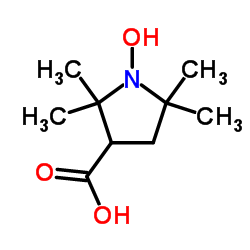3-carboxy-proxyl

3-carboxy-proxyl structure
|
Common Name | 3-carboxy-proxyl | ||
|---|---|---|---|---|
| CAS Number | 2154-68-9 | Molecular Weight | 187.236 | |
| Density | 1.1±0.1 g/cm3 | Boiling Point | 307.2±31.0 °C at 760 mmHg | |
| Molecular Formula | C9H17NO3 | Melting Point | 200ºC (dec.) | |
| MSDS | Chinese USA | Flash Point | 139.6±24.8 °C | |
|
Role of mitochondria in the leishmanicidal effects and toxicity of acyl phloroglucinol derivatives: nemorosone and guttiferone A.
Parasitology 142 , 1239-48, (2015) Nemorosone (Nem) and guttiferone A (GutA) are acyl phloroglucinol derivatives (APD) that are present in different natural products. For both compounds anti-cancer and anti-microbial properties have been reported. In particular, an anti-leishmanial activity of... |
|
|
Gd(III)-PyMTA label is suitable for in-cell EPR.
J. Am. Chem. Soc. 136(43) , 15366-78, (2014) Distance measurement in the nanometer range by electron paramagnetic resonance spectroscopy (EPR) in combination with site-directed spin labeling is a very powerful tool to monitor the structure and dynamics of biomacromolecules in their natural environment. ... |
|
|
Deciphering the underlying mechanisms of oxidation-state dependent cytotoxicity of graphene oxide on mammalian cells.
Toxicol. Lett. 237 , 61-71, (2015) The promising broad applications of graphene oxide (GO) derivatives in biomedicine have raised concerns about their safety on biological organisms. However, correlations between the physicochemical properties, especially oxidation degree of GOs and their toxi... |
|
|
ESR measurement of radical clearance in lung of whole mouse.
Biochem. Biophys. Res. Commun. 177(2) , 874-80, (1991) Clearance of the nitroxide radicals, hydroxy-TEMPO and carboxy-PROXYL, in whole-mouse lung was directly measured by in vivo ESR. After injecting a nitroxide radical, distribution of the nitroxide radical all over the lung was confirmed by ESR imaging. The ESR... |
|
|
Nitroxide free radical clearance in the live rat monitored by radio-frequency CW-EPR and PEDRI.
Phys. Med. Biol. 43(7) , 1899-905, (1998) The use of RF (100 to 300 MHz) PEDRI and CW-EPR techniques allows the in vivo study of large animals such as whole rats and rabbits. Recently a PEDRI instrument was modified to also allow CW-EPR spectroscopy with samples of similar size and under the same exp... |
|
|
Whole mouse nitroxide free radical pharmacokinetics by low frequency electron paramagnetic resonance.
Biochem. Biophys. Res. Commun. 166(1) , 168-73, (1990) The in vivo uptake distribution and reduction of the oxygen-sensitive nitroxide spin label PCA in the mouse monitored by low frequency electron paramagnetic resonance (EPR) spectroscopy are reported. Spectra were obtained from the head and liver regions of pe... |
|
|
Whole rat electron paramagnetic resonance imaging of a nitroxide free radical by a radio frequency (280 MHz) spectrometer.
Biochem. Biophys. Res. Commun. 183(2) , 829-35, (1992) Low frequency (280 MHz) electron paramagnetic resonance spectroscopy has been used to follow uptake, distribution and reduction of the nitroxyl spin label PCA in the rat. No difference of half life was found in seven rats submitted to three administrations of... |
|
|
Metabolic fate in the dog of the nitroxide moiety in a compound with potential utility as a contrast agent in MRI.
Magn. Reson. Med. 5(1) , 73-7, (1987) Nitroxides, paramagnetic compounds with demonstrated effectiveness as contrast agents in proton magnetic resonance imaging, shorten the relaxation times of protons and therefore cause an increase in image intensity in tissues into which they distribute. In th... |
|
|
Comparison of ionic and non-ionic nitroxide spin labels for urographic enhancement in magnetic resonance imaging.
Acta radiol. 28(5) , 593-600, (1987) Two nitroxide spin labels (NSL) were compared for in vitro relaxivity and in normal rats for efficiency of urographic enhancement. One of the NSL, PCA, a pyrrolidinyl agent, was ionic and one, NAT, was a non-ionic pyrrolidinyl NSL with multiple hydroxyl subst... |
|
|
Effect of hyperthermia on lymphocyte plasma membrane. 3 electrolyte spin labels permeability.
Cytobios. 58(234-35) , 165-70, (1989) The effect of elevated temperatures on the transport of electrolyte spin labels anionic c-TEMPIR and cationic TEMPO-choline character across the porcine lymphocyte plasma membrane was investigated. Breaks in the Arrhenius plot for permeability of both spin-la... |